The Model 1911
by North American correspondent Thomas Tabor
Australian & New Zealand Handgun 9
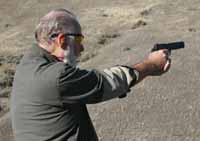
The US Government Model 1911
being taken through its paces.
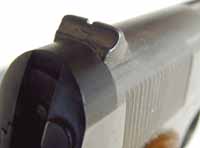
The rear-sight of the 1911 was a
standard notched fixed style.
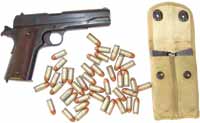
Sometime after this Model 1911
left the US Military, the Parkerised
finish was removed and replaced
with a more pleasing to the eye
blued finish. Other than that
change, it remained as it was
used by the US troops.
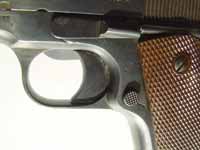
The magazine is released by
compressing the round chequered
button located behind the trigger
near the top of the grip.

Thomas Tabor’s test Government
Model 1911 was built for the US
Armed Forces, which is reflected
on the side of the slide. Of all of the firearms used by the world’s military commands, I know of none that has experienced a longer reign and seen more battles and conflicts than the Model 1911 pistol. This self-loading handgun, chambered in the .45 ACP calibre, was the handgun of choice used by the US troops in World War I, World War II, the Korean Conflict and Vietnam. More recently, it played a pivotal role for some of the specialised US Army Special Forces and Marine Corp units involved in the Persian Gulf conflicts of Desert Storm, Operation Iraqi Freedom and Operation Enduring Freedom.
A military heritage
The design of the Model 1911 makes it a near perfect match for wartime use. This stalwart veteran has the ability to handle virtually any type of conflict, under any type of conditions, and still function flawlessly time after time. Like the Duracell Bunny, the 1911 just keeps on going and going and going. Or maybe it would be more appropriate to say that when it comes to the 1911, it just keeps on shooting and shooting and shooting.
I’ve often been told that during battle, you could literally submerge a 1911 in a mud-hole and as long as the bore was clear, it would continue to cycle, function and shoot as if nothing had happened. Certainly, not too many of today’s-designed self-loading firearms could make such a claim.
In all fairness, however, it is important to note than virtually nothing in life is absolutely perfect and this handgun is no exception. As issued to the US Armed Forces, the 1911s were not what anyone would characterise as ‘tack-driving’ firearms. In fact, their reputation as being inaccurate was quite well known by most in the military. While modifications were sometimes possible to improve on their accuracy, in most cases, the frontline battle troops seldom saw such improvements made to their firearms.
Many years ago, I heard of a high-ranking US General being questioned as to why the 1911 had such a long-running tenor with the US Forces. While I can’t recall the General’s name, his response has remained with me over the years. He said that the military issued these firearms to their troops primarily for psychological reasons. Just the knowledge that a large-calibre handgun was at the ready and strapped to the hip of the GI provided a significant degree of confidence. The General went on to say that very few enemies were ever actually shot or killed by a 1911, but the psychological significance that they provided the troops was deemed worthwhile.
Before I go any further, I’d like to make one thing clear - when I speak of the Model 1911’s propensity to be inaccurate, I am only talking about the standard military-issue handguns. The problems associated with the lack of accuracy were assuredly the result of mass-production, where primary emphasis was placed on the speed at which they could be produced and put in the hands of the troops. While the overall quality was excellent for a military-type firearm, the parts were not hand-fitted. This allowed repairs to be accomplished more easily by being able to exchange parts as needed, even while on the battlefield. While the quality of these military-issue firearms were certainly exceptionally good, I would have to admit that the modern-produced 1911s are considerably better, both in functionality and appearance.
Like so many of today’s best firearms, the Model 1911 was one of the many designs developed by John Browning. As the model name would seem to indicate, production began in 1911, with the Government model ending nearly 60 years later in 1970. During that time, the model changed very little, but in 1923, a couple of improvements were made, including the replacement of the mainspring housing with a chequered arched housing and replacement of the grip safety spur with a longer one. These features are included on the M1911A1. Most, if not all, of the government-issued handguns came with a Parkerised finish, while the commercial versions were most often blued. A letter ‘C’ preceding or following the serial number indicates that the particular handgun was made for commercial purposes, rather than for the military use.
In order to supply the US Military with an adequate number of these handguns, Colt granted permission over the years to various other firearms manufacturers to produce them. This included the companies of Ithaca Gun Co, North American Arms Co Ltd (Canada), Remington Rand Co, Remington UMC, Singer Sewing Machine Co and Union Switch & Signal Company. Some were also made at the Springfield Armory.
Shooting the Model 1911
I was keen to evaluate the Government Model 1911’s functionality and ability to shoot accurately for myself, so when the opportunity came up to test one, I jumped at the chance. This was the first time that I had actually had any significant exposure to one of these handguns since I served in the US Navy back in the late 1960s. As a GI-issued firearm, the test piece had once possessed the standard Parkerised military finish, but somewhere along the trial, it had been refinished and now had a semi-gloss blued finish. While this clearly improved the overall appearance of this particular pistol, this action quite likely lessened its value as a collectable piece. Other than that change, it was original, all inclusive of a military leather holster, web belt, magazine pouches and a sizeable amount of the old military ammunition from the WWII era.
It would have been nice to know the full history behind this particular battle-scarred old veteran, but unfortunately, my knowledge of where it came from only dates back to when it was purchased as a military surplus item. I believe it was in the late 1960s or possibly the early 1970s, when the US National Rifle Association (NRA) purchased a huge number of surplus military firearms and offered them for sale to their membership. Of course, this was before the laws of the nation prohibited such transactions through a mail-order-type system. This 1911 was one of those.
At that time, the NRA offered each member the opportunity to purchase one each of a Model A303 rifle, self-loading M1 Garand, self-loading M1 Carbine and Model 1911 pistol. If I recall correctly, the prices to the membership ran from about $US14 to $US24. The only exception to those phenomenally low prices was in the case of the Garand, which was offered later on and carried a considerably higher price tag. Unfortunately, at that time in my life, it may have just as well been $5000 each and I was unable to take advantage of the sale.
The military cartridges that accompanied this handgun were also undoubtedly the result of military surplus sales released for civilian use and carried headstamp dates from 1942 to 1954. I thought it would be both interesting and appropriate to include some of this old ammunition in my live-fire testing, but before I did so, I pulled a few of the bullets in order to assess the internal condition of the components. The necks of the cases were heavily crimped around the bullets, making them somewhat difficult to extract, but when they were pulled and the contents examined, I found no signs of deterioration. Appearance-wise, the powder looked to be in perfect condition and there was no tattletale odours indicating that the powder had started to deteriorate. I decided to give the cartridges a whirl and was pleasantly surprised by the shooting results. The nearly 70-year-old ammo shot remarkably well, with what I would call fairly acceptable groups in this venerable gun.
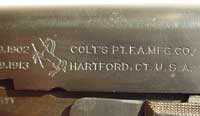
Thomas Tabor’s Model 1911 was
built by Colt, but many other
manufacturers were called upon
to produce these guns for the
US Military.
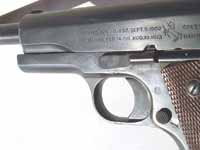
A slide lock is engaged after firing
the last cartridge or it can be
engaged manually.
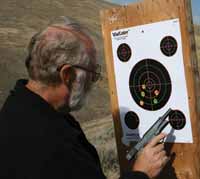
While the military version 1911 has
never been known for its accuracy,
Thomas Tabor was pleasantly
surprised at some of the groups.
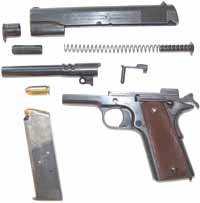
Field-stripping the 1911 for
cleaning is an easy operation.I also shot a variety of newly produced ammunition and some of my own handloaded cartridges. The factory rounds were exclusively produced by Federal Ammunition and consisted of their American Eagle, Federal Champion and Federal Premium PD loads. The Federal Champion and American Eagle cartridges were loaded with similar-style full metal jacket 230-grain bullets, while the PD rounds contained hollow-point bullets and were also 230 grains. The military surplus ammo was loaded with the typical full metal jacket bullets and weighed 230 grains. My own handloaded cartridges contained hollow-point bullets made and sold by Speer in a combination the weights of 230 and 225 grains.
As mentioned, the military-issue 1911s were never known for their accuracy, but my handgun surprised me as to its ability. As can be seen in the accompanying chart, it really didn’t shoot that badly, at least at the relative close range of 10m. While I have to admit that I shot some much larger groups with each type of ammunition, I would consider all of shown groups to be perfectly acceptable, particularly for the use it was intended for on the battlefield.
From my own prospective, one thing I found interesting was how the empty cases were ejected. Rather than flinging them out to the right of the shooter, as is typical for most self-loading handguns, my 1911 threw the shells high and overhead, with most of them eventually landing on the ground behind me. While this might not be considered an important issue to some, after owning and firing many different self-loading handguns over the years, I found it to be somewhat different and distinctive.
| Best five-shot groups at 10m | ||
| Ammunition | Group | |
| Federal Champion factory load | 4.5" (11cm) | |
| Federal American Eagle factory load | 4.5" (11cm) | |
| Federal PD factory load | 4.75" (12cm) | |
| Speer 225-grain HP handload* | 4.5" (11cm) | |
| Speer 230-grain HP handload** | 2.75" (7cm) | |
| Military surplus ammo | 3.375" (9cm) | |
| * The best handload consisted of 225 grains of 4479, hollow-point bullets, 10 grains of Blue Dot powder, CCI-300 Large Pistol primers and Federal cases. | ||
| ** The best handload consisted of 230 grains of 4483, Gold Dot hollow-point bullets, 6 grains of Unique powder, CCI-300 Large Pistol primers and Federal cases. | ||
| These handloads were developed under controlled circumstances from reloading manuals and other reliable information and specifically pertains to these components. This same data may not be appropriate for all Model 1911 pistols. When reloading, start with powder levels less than those listed and gradually work up from there, continually checking for signs of excessive pressure levels. | ||
Summary
Outside of the fact that the GI-issued 1911s are excellent and well-built handguns, many shooters are particularly fond of 1911s because of their long-standing battle record. I for one certainly would fall into that category on both counts.
More recently, many of the world’s top-quality handgun manufacturers are now offering their versions of John Browning’s Model 1911 that are even better. In many cases, these share the common lines of the old military pistols, but include many improvements. Essentially, they have taken a really great firearm and made it even better, in many cases including a propensity for better shooting accuracy. Often, these new models are nothing short of a gunsmithing work of art, but the old GI-issued 1911s will continue to be one of my favourite handguns.
Specifications
Manufacturer: Colt PT FA
Manufacturing Company
Model: 1911
Calibre: .45 ACP
Weight: 39oz (110g)
Sights: Fixed rear and front
Action: Self-loading, recoil-operated, single-action
Barrel: 5" (12.7cm)
Overall Length: 8.5" (21.59cm)
Grips: Plastic chequered
Magazine: Z-Stacked magazine holding seven cartridges
RRP: Original 1911s are available only on the secondhand open market with varying prices depending upon the condition. Ask your local gunshop for modern models or reproductions.
